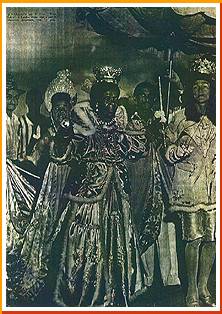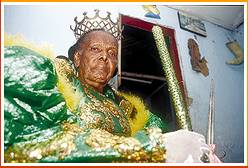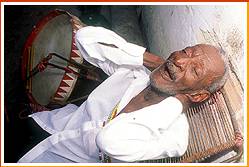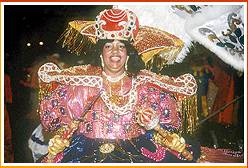

DONA SANTA
- Queen and Yalorisha2 |
 |
CENTURIES
OF AFRICAN NATIONS
During
its heyday, the Elephant Maracatu, according to Guerra Peixe, made
its procession through the streets in 1928 with the following
components: the King, the Queen, lady-in-waiting to the Queen,
and lady-in-waiting to the king, prince, princess, lady-in-waiting to the minister, the minister,
lady-in-waiting
to the ambassador, the ambassador, duke, duchess, count, countess, four
subjects, another four subjects, three Calungas, or dolls, (Luis,
Leopoldina, Emilia), three female dancers (responsible for the Calungas
during the procession), the standard-bearer, a male slave
(responsible for carrying the great parasol), the figures of the
tiger and the elephant, the guardian of the crown jewels, the
herald, the procession majorette, the secretary, the lance-bearers
(three boys), three bodyguards, the band (fifteen musicians), twenty
caboclos (Brazilian half breed natives - white and native)
and twenty baianas (referred to in the last section). The court procession numbered
around one hundred and fifty participants.
The orchestra of a
nation Maracatu, known as baque virado1
(a double beat), is made up entirely of
percussion instruments, unlike the Orchestra Maracatus, which almost
always have one trombone and several wind instruments. |

DONA MADALENA
- Queen and Yalorisha2
Photo: Pio Figueiroa |
 | Guerra Peixe, in Maracatus of Recife, describes its batuque
- or beat - in the following manner: "the tarol (a type of tambourine)
gently announces the very simple rhythmic scheme, with beats, interspersed
with pauses that come almost at the same instant . A deep, bass drum signals the
characteristic rhythm of the maracatu. Following this, it is the turn of
the war drums. By this moment, the tarol
has finished its initial scheme of variations and from this point on, the zabumbas
(bongos) enter the proceedings with their distinct, strong, rhythmic
beats. Shortly after this, the meião (a medium sized, deep
sounding drum), follows the beat of the
leader and together they ring out the peals of the rhythm. The sound increases and
intensifies at a tremendous rate, as the entire group breaks
into action. At almost the same moment as the final instruments enter, the
baianas respond by singing the chorus. The chorus is repeated and
the bongos go through a series of variations. This is interrupted each time that
the queen (or the director, as in the case of the Crowned Lion Maracatu)
sings
her/ his solo.

LUIZ DE FRANÇA -
Religious leader of Ifá
Photo: Pio
Figueiroa |
 |
Once more, the chorus enters and the variations are repeated. Each
time this occurs, the intensity increases and the beat accelerates. All of
this, in
order to compete with the chorus of the baianas and to overpower them.
On reaching a musical climax, for some time after, the beat remains with a single beat,
increasing violently with each new beat. All at once, the queen's
whistle (the queen being responsible for the group) is heard over the
beat, warning everybody that the music is coming to an end. Everybody pays
very close attention for the second whistle, which will come at the exact
finishing moment of the music - the very last note. Suddenly, and with total
precision, the whole
group halts at the same moment . There is a mute
beat - the beat stops".

DONA ELDA - Queen
and Yalorisha2
Photo: Flávia
Lacerda |
The orchestra of a nation maracatu almost always comprises a deep,
bass drum,
a tarol (a kind of trombone) two war drums and nine bongos. It is
also possible to find a ganzá (a large maraca), and the number of
bongos can vary depending on the size, and financial possibilities of the group.
Preserving
the entity of the nation, processions of maracatu de baque virado
(maracatus with a double beat, as explained above, which only use
percussion instruments of African origin) continue to parade through the
streets of Recife during carnival, as well as the preceding months leading
up to it. The most well-known are : Nação do Elefante (1800) (The
Elephant Nation) ,
Nação do Leão Coroado (1863) (The Crowned Lion Nation), Nação da Estrela Brilhante
(1910) (The Shining Star Nation), Nação do
Indiano (1949) (The Indian Nation), Nação Porto Rico (1915) (The Porto
Rico Nation), Nação Cambinda Estrela (1953) (The Cambinda3 Star Nation). There are also numerous other groups that have
appeared more recently, in order to preserve the African traditions of
their ancestors.
1 See Maracatu Baque Solto for an explanation
of the
maracatu
rhythms.
2 The female leaders of the African
religions.
3 See Maracatu Baque Solto for
references to Cambinda.

|